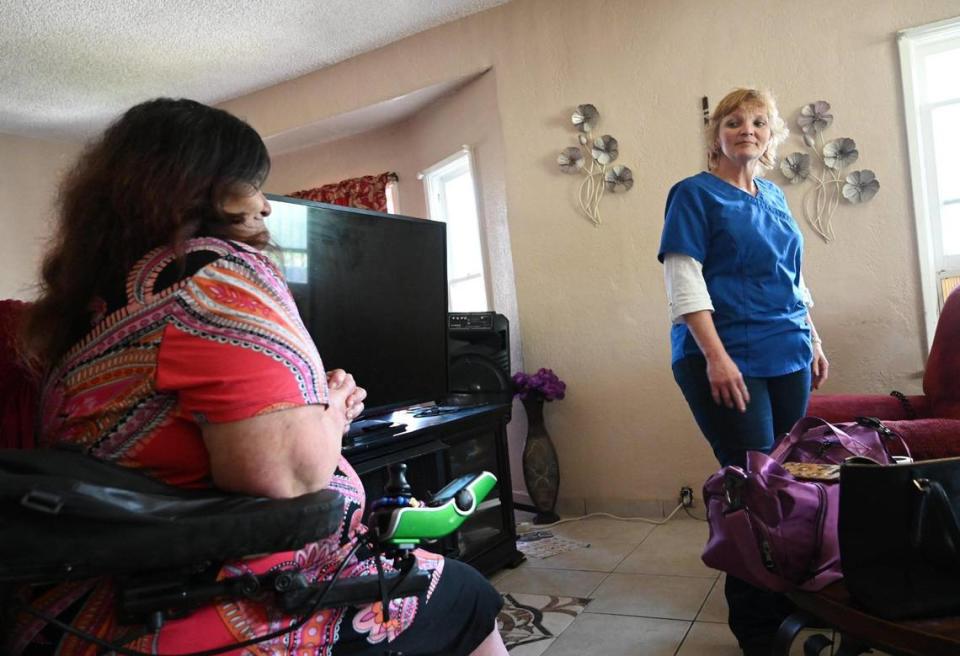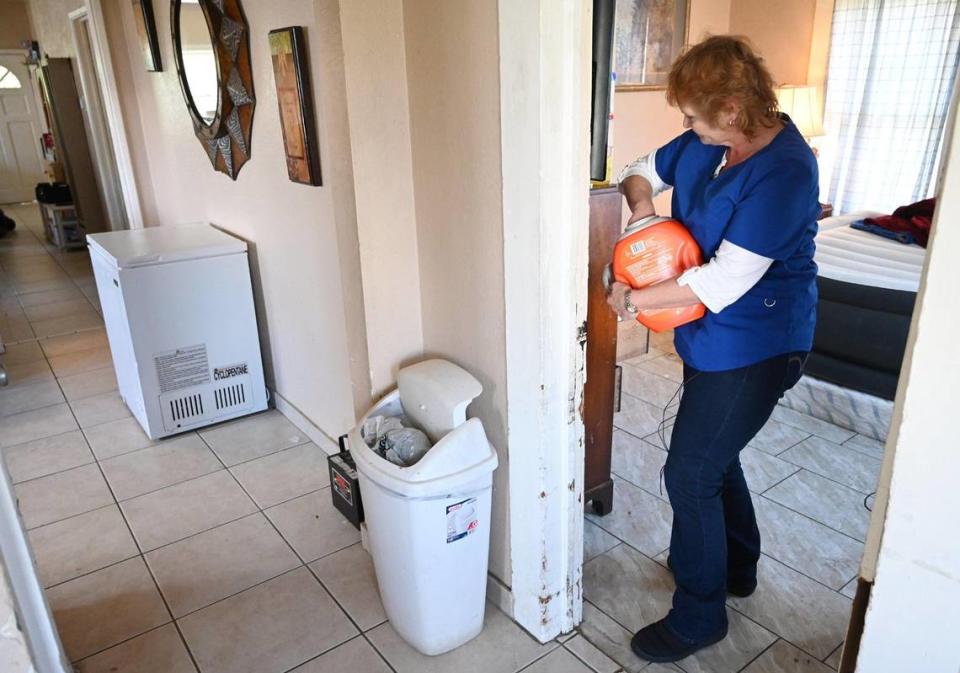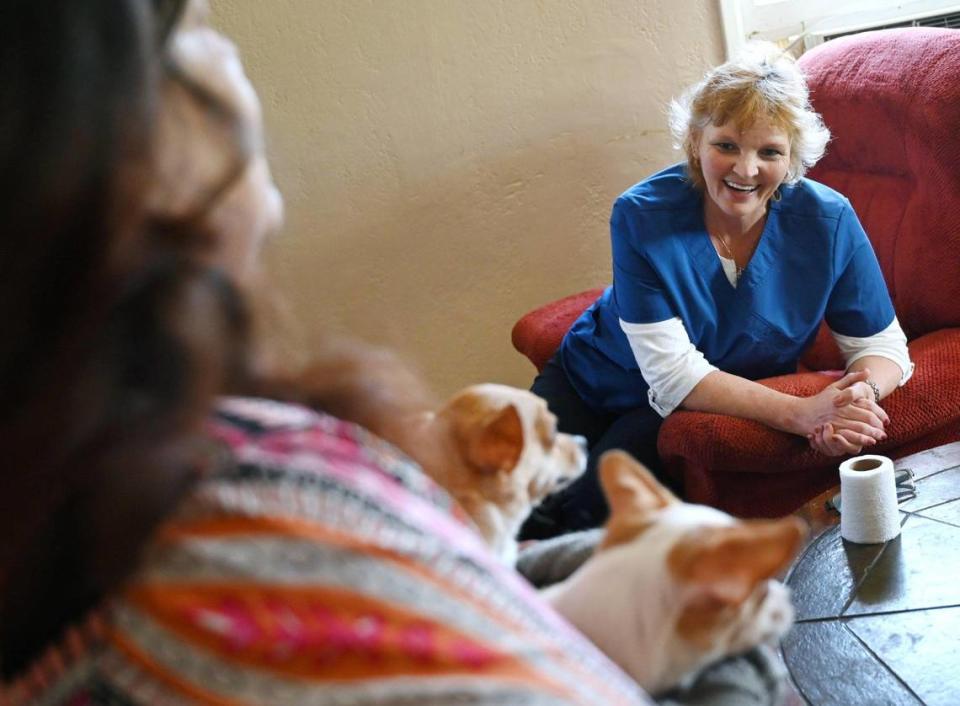Over 23,000 Fresno County residents rely on this workforce. Will the workers get a raise?
As California faces a “silver tsunami,” care workers who help the elderly and disabled live independently in their homes are fighting for a better wage they say is necessary to sustain them.
Over 23,000 Fresno County residents rely on the publicly funded In-Home Support Services program, a number that county officials expect to grow.
Administered by the Department of Social Services, California’s IHSS program provides eligible individuals with in-home care services to keep people living safely in their homes. IHSS workers typically help individuals with basic needs such as bathing, feeding, grocery shopping, and mobility and restroom assistance.
The IHSS program allows wheelchair-bound care recipient Jovonna “JoJo” Martinez to stay in her own home. She said she “wouldn’t last” in a long-term care facility because she fears both the living conditions as well as losing individualized care.
“Without my in-home service care worker, honestly, I would be in a convalescent hospital,” she said in an interview with The Bee/Fresnoland. “And the thought of that just terrifies me.”

Martinez started utilizing the IHSS program over 10 years ago when she developed cataracts that were causing her to go blind. Last year, she broke her hip, which — in addition to existing thyroid-related weight issues, knee problems and degenerative disc disease — has made it even more difficult for her to complete basic tasks like grocery shopping, cleaning the house, and using the restroom.
“I can’t tell you how many times I’ve slipped out of bed and called (my caretaker) in the middle of the night, and she’s come and rescued me,” Martinez said.
Fresno County’s caretaker program will grow
More Fresno County residents are expected to utilize home care services in the coming years due to the region’s aging population as well as the expanded eligibility for Medi-Cal, according to Sanja Bugay, head of Fresno County’s Department of Social Services. Population projections from the California Department of Finance estimate that by 2050,18% of Fresno County residents, or 230,770 of 1,226,158, will be over the age of 65.
Bugay said that the program has grown consistently in recent years, a trend she expects to continue. From 2021 to 2022, the program grew by 5%, from 2020 to 2021, it grew by under 2%. Meanwhile, the years prior to that saw about 5% to 6% growth each year, she said.
Currently, 47% of Fresno County’s IHSS recipients are elderly, while 43% are disabled adults, and 10% are minors.
“People have talked about the ‘silver tsunami,’” Bugay said, “and we want to keep this population out of institutional care.”
While Fresno County officials say they are able to find IHSS workers to fill the demand for requested service hours, union officials argue otherwise.
Bugay said the county doesn’t “have a challenge when it comes to recipients finding providers.”
However, union officials said that in 2022 over 951,000 hours went unfilled in Fresno County alone. Part of the problem is that one in four IHSS workers leaves the profession each year due to the low-pay, according to Service Employees International Union 2015 President, Arnulfo De La Cruz, the union that represents Fresno County’s IHSS caregivers.
“Who would you want taking care of your loved one?” he said. “Would you want someone who’s making minimum wage and benefits, or someone who’s able to care for their own families, too?”
Fight for $20 per hour
On a late Wednesday morning in mid-March, IHSS caregiver Wendy Davenport reported for duty at Martinez’s central Fresno home.
That day, Davenport helped Martinez wash her bedding, tidy up the house, and pack a suitcase for an upcoming trip. Davenport also typically helps Martinez get in and out of the shower, get dressed, and prepare meals.

Davenport, who has been an IHSS caregiver for over 10 years, works about 20 hours a week with Martinez and 10 hours a week with another client. And while she loves her job, she struggles to pay off basic monthly bills like car insurance, especially after her husband had a heart attack last year and couldn’t work.
“I don’t think that those little bills should be that big of an issue for me,” she said, “but they are.”
Demand for caregivers is on the rise in California and union leaders, workers, and some economists, say higher wages are crucial to attract and retain the growing caretaker workforce.
Currently, Fresno County has an estimated 18,000-20,000 IHSS workers, “which makes it the largest public workforce in the county,” De La Cruz said.
Earlier this year, the SEIU Local 2015 started the bargaining process for a new contract with Fresno County – a process that Dereck Smith, executive vice president for the union, said he hopes will be complete “within the next couple of months.”
Negotiations for the recently-expired three-year contract culminated in 2019, after eight years of bargaining, union officials said. The process was marked by care workers and labor activist and United Farm Worker co-founder Dolores Huerta getting handcuffed and removed from a Fresno County Board of Supervisors meeting.
“The last negotiation (with Fresno County) took a very long time,” he said, “and we’re hoping that we don’t have to escalate and be at the Board of Supervisors week after week.”
One major priority for the union is securing a raise from $16.10 to $20 per hour for IHSS workers. Aside from arguing that the grueling work justifies this pay raise, union officials and workers say increased wages will help the local economy because care workers generate tax revenue and contribute to the local economy.
“With the price of things today, that’s what we feel will be necessary just to survive,” Davenport said. “It’s the least we deserve.”
How much would this cost?
Currently the IHSS program costs $688 million to fund in Fresno County alone. However, the county’s share of this cost is around $52 million, while the state and federal government cover the rest of the program costs, Bugay said in an email statement to The Bee.
Bugay estimates that a raise to $20 for IHSS workers would cost a total of $103.7 million, with the federal government covering $50 million, the state $17 million, and the county $31 million. SEIU 2015 representatives similarly told The Bee that the increased wages would cost around $29 million to Fresno County.
Smith, of the SEIU 2015, also discussed the idea of adding just one dollar on top of current wages to put Fresno County care workers on “on a path to $20.”
While the raise would mean increased costs, union representatives, researchers, and economists say the program saves taxpayers money in the long run.
Keeping people out of hospitals is “so crucial” in this ongoing pandemic, Hannah Archambault, assistant professor of economics at Fresno State said.
Immunocompromised, elderly, and people with disabilities “suddenly (become) really expensive in a hospital.”
A 2021 report from the California State Auditor said that the IHSS program saves the state millions of dollars — between $22,000 and $153,000 annually per recipient — since these individuals would likely otherwise be placed in long-term care.
Good pay, Archambault said, is essential to keep workers in the field.
Oftentimes, caregivers – who nationwide tend to be women of color – are overworked, she said, either because they are demanded to work more hours by their bosses, or because they need to take those hours to make ends meet.
“For these services to be adequate, let alone outstanding or excellent — which is what we should want from our provision of health care services,” she said, “it’s absolutely crucial that these workers are paid more.”

Negotiations may change from county to state
This could be the last time SEIU 2015 bargains with Fresno County, as the union recently sponsored a bill that would shift bargaining from the county level to the state level.
Authored by Assemblyman Matt Haney, D-San Francisco, the In-Home Support Services Employee-Employer Relations Act, would create a “more efficient way” of planning to attract “caregivers for the future,” De La Cruz said.
“We’re in this space now where there’s a lack of caregivers, all of these consumers (IHSS recipients) can’t find a caregiver,” he said, “and then we’re forced to work at the county level to figure this out. I just think that we can do much better than that.”
Bugay, of DSS, said she’d be supportive of statewide bargaining “as long as … our local costs are really paid attention to. ”
The bill is working its way through the Legislature and has an appropriations committee hearing scheduled on April 26.
Ultimately, union officials want the public to understand that, at some point, everyone will need care.
“There’s really only two types of people as it relates to care: those who are currently needing it,” De La Cruz said, “and those of us who are going to need it at some point.”

